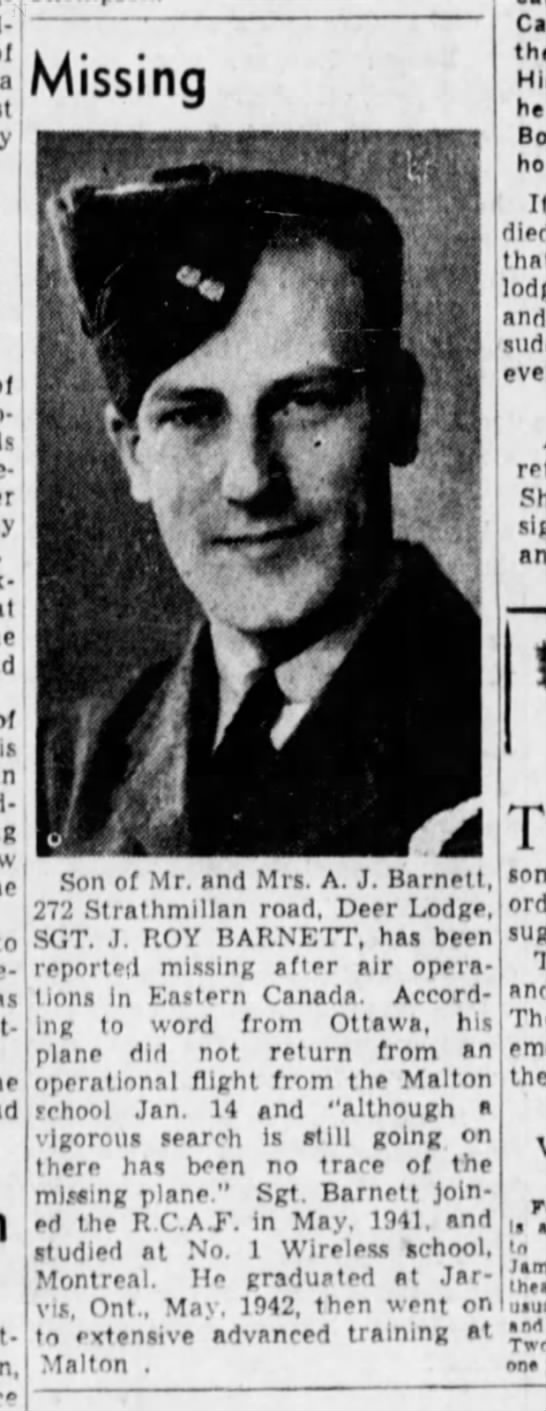
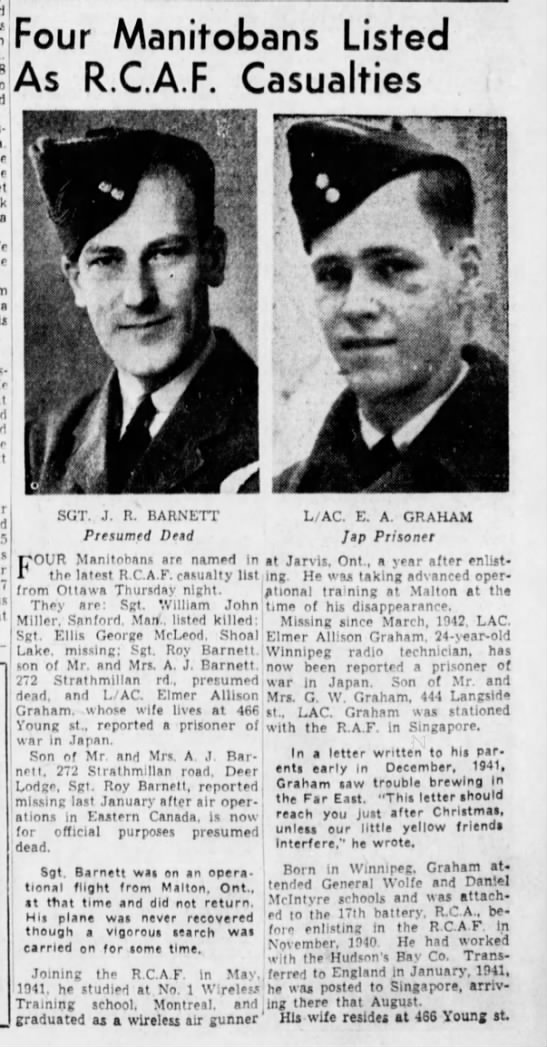
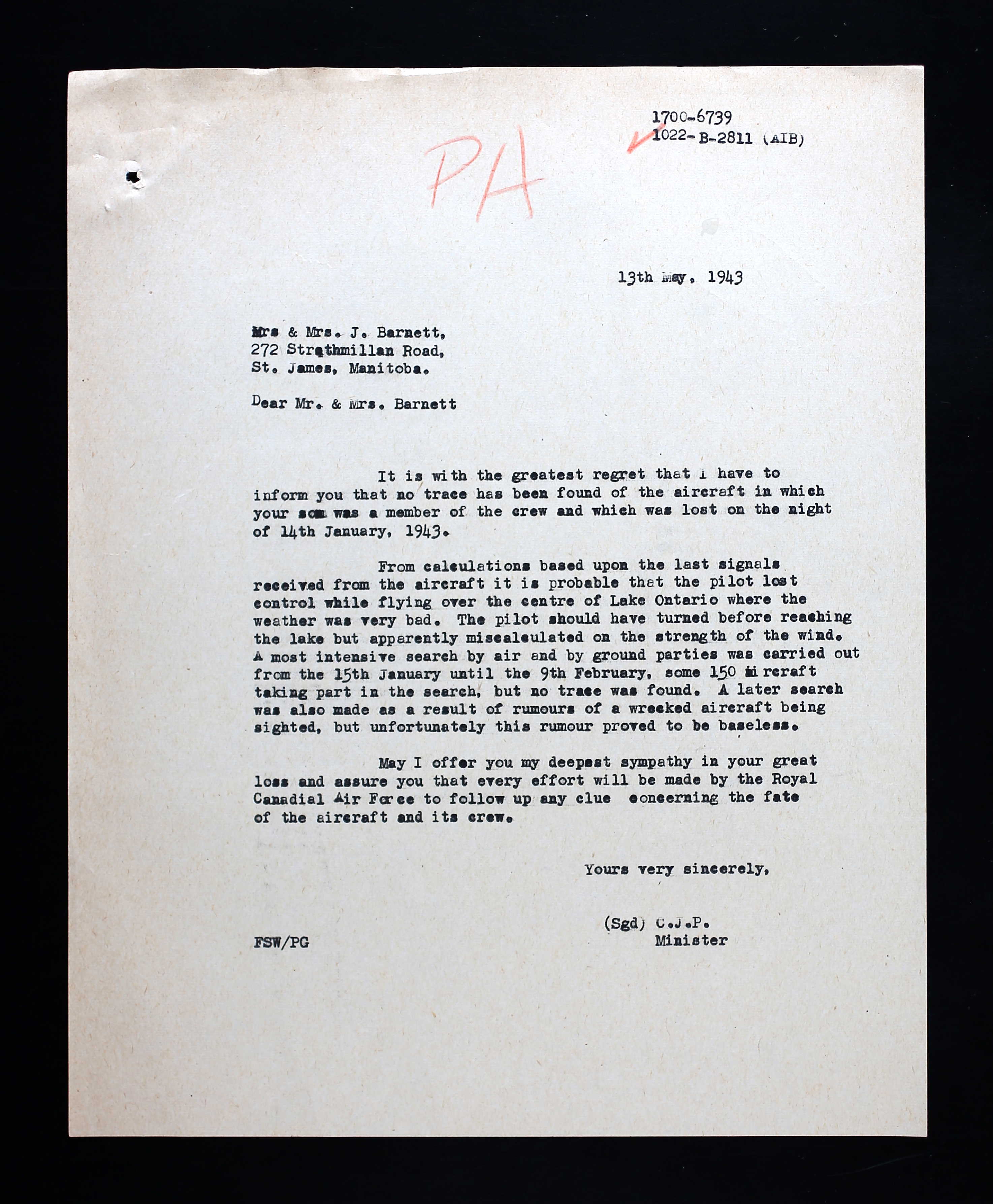
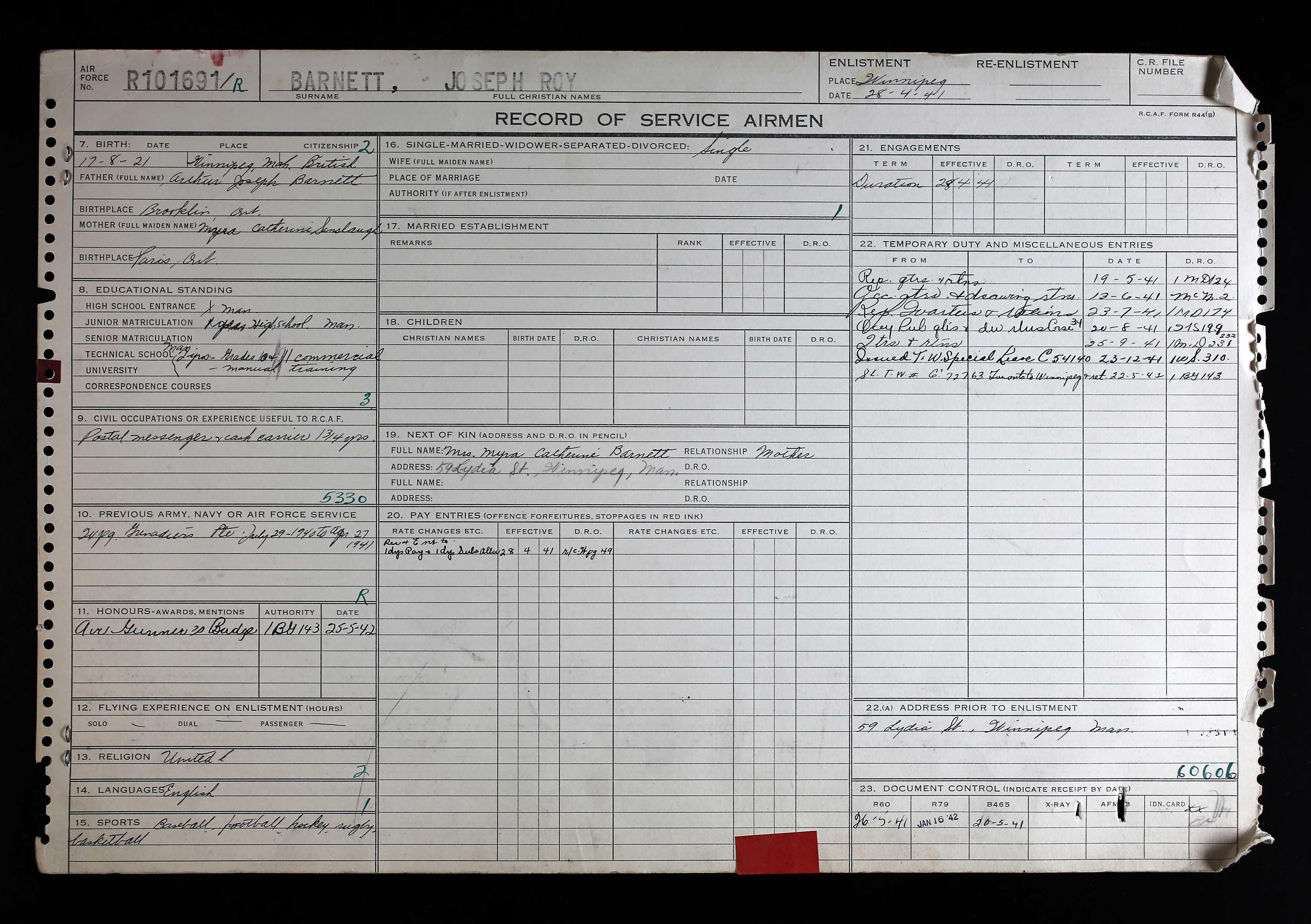
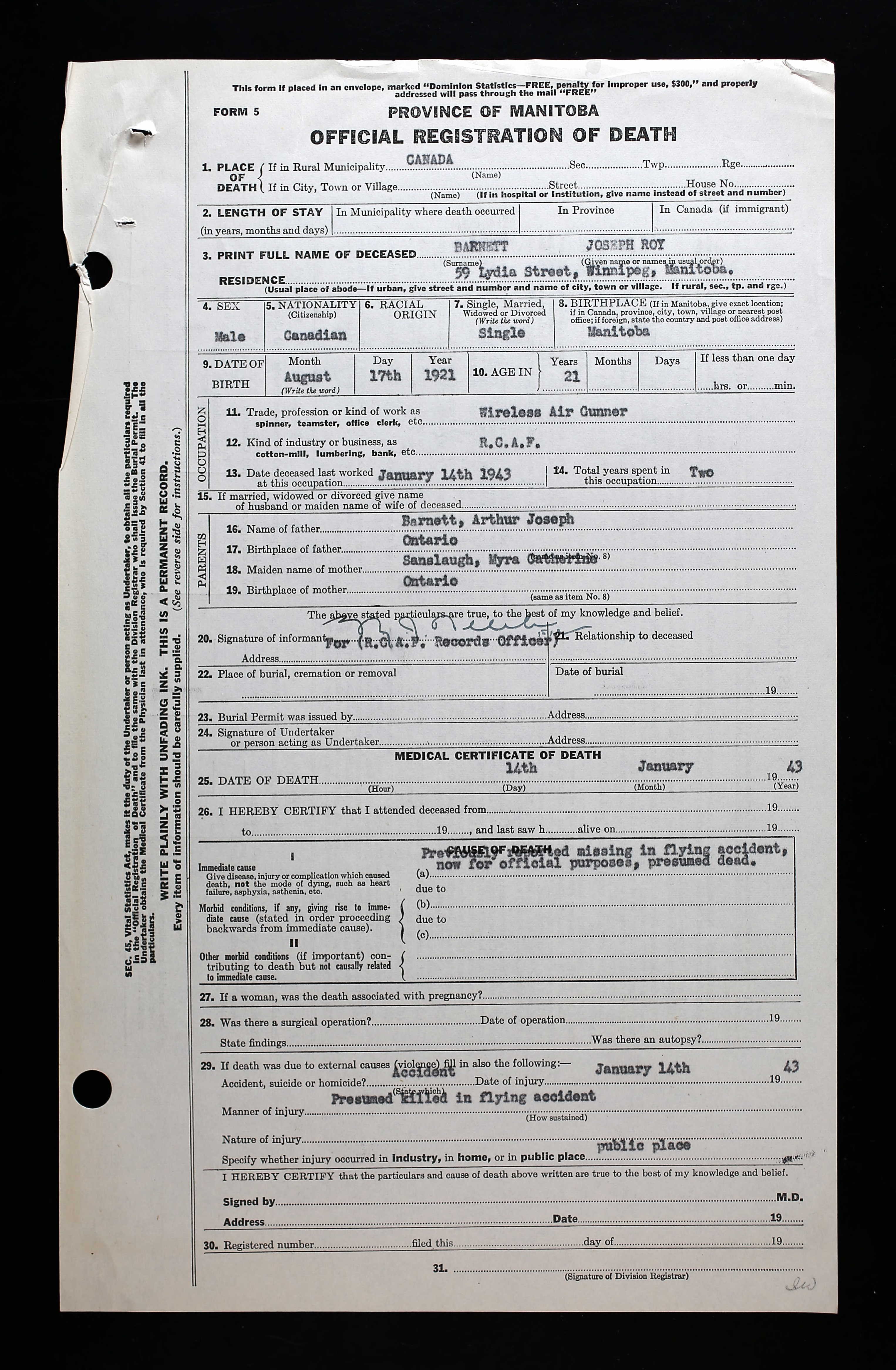
August 17, 1921 - January 14, 1943





Joseph Roy Barnett was the son of Arthur Joseph Barnett (1888-1964), furniture finisher, and Myra Catherine (nee Sanslaugh) Barnett (1883-1987) of St. James, Manitoba, a suburb of Winnipeg. He had one sister, Grace; one brother, Howard, died as an infant. The family was Protestant and attended the United Church.
He enjoyed baseball, hockey, rugby, and basketball. He had junior matriculation. He had previous military experience from July 1940 to April 1941 with the Winnipeg Grenadiers. He filled in his forms: Roy Joseph.
Joseph initially made application to the RCAF in 1939, but ‘no result.’ He had shorthand (80 wpm) and typing (40wpm) taken at school in his Grade XI term.
In 1926, he had a left orchidectomy (removal of testicle possibly due to hernia) and in 1929, he had a laceration to the bridge of his nose, but no fracture occurred.
Prior to enlisting with the RCAF, he was an office clerk, cash carrier and postal messenger for T. Eaton Co. Joseph was accepted into the RCAF April 28, 1941. On one RCAF form dated August 28, 1941, Joseph stood 5’7” tall and weighed 137 pounds. “Wants Observer, Pilot, Wireless Operator Ground…Somewhat immature, excitable and worried on tests. Average education. Anxious to succeed. Best as Pilot, if steadies down, otherwise, ground crew.”
Joseph started his journey through the BCATP on when he was sent to No. 1 Manning Depot, Toronto, May 18, 1941. He was then sent to RCAF Detachment, McMaster University June 14 until returning to Manning Depot August 29th before being sent to No. 1 ITS, Toronto August 21, 1941. He was at the station hospital from August 4 – 11, 1941.
He was then sent back to Manning Depot September 26 until November 8, 1941. “Average type who really worked hard but was not high enough in the mathematics to justify Observer posting which he desired. Too low in Link work for pupil pilot – recommended as Wireless Operator Air Gunner.”
Joseph was sent to No. 1 Wireless School, Montreal, November 9, 1941 until April 25, 1942. “70.4%. 66th out of 70 in class. Steady and most reliable; will be a good man in a jam.” Jarvis, Ontario, and No. 1 B&G School was his next destination from April 26 to June 9, 1942, where he received his Air Gunner’s Badge on May 25, 1942. He was 33rd out of 34 in his class. “Rather slow but a really hard worker, was pulled down in his position by poor firing results.”
Joseph was posted to No. 1 Air Observers School, Malton, Ontario June 10, 1942.
On January 14, 1943, he was missing after a routine navigation flight. He was the Wireless Air Gunner. Three other crew members were aboard: Sgt. R. H. Cochran, Pilot, K. N. Miller, Second Navigator and Gordon Charles Bricker, First Navigator.
On February 25, 1943, a Court of Inquiry was struck to investigate the missing Anson I 6739. Three witnesses were called to the Court of Inquiry held later in February 1943 to investigate.
The third witness, J. F. Copeland, Operations manager, Dominion Skyways, (Training) Limited, operating No. 1 AOS, Malton, Ontario stated that Anson aircraft 6739 was detailed to carry out a routine night navigation flight. The route was Malton to Brampton to Barrie to Newcastle to Tweed to Brampton and return to Malton. the recorded airborne time was 00: 30 on the 14th day of January 1943 and was last heard from wireless transmission at 01: 15 reporting over Barrie at 0100 hours at 3000 feet. at 05: 15 the aircraft was considered overdue and the RCAF was informed. A search was immediately started and carried out. The weather reported by other pilots on the flight indicated that there was broken cloud and good visibility but as they approached Lake Ontario where the overcast was solid and variable in height from 2000 to 3000 feet above the ground with intermittent snow showers with visibility decreasing in showers to one mile. Over the lake the clouds were more dense and the snow quite heavy which was due mostly to lake effect or instability over the lake. On the leg from Newcastle to Tweed, the conditions were variable with occasional showers decreasing in intensity away from the lake, visibility was only fair 3 to 8 miles. The leg from Tweed to Brampton was variable with an increasing amount of snow as they neared Brampton with visibility going down to one mile at times and ceilings generally 2500 to 3000 above terrain. Other pilots reported as having completed this particular leg in 28 to 30 minutes. If the pilot had flown out his estimated time of arrival of 53 minutes and assuming that he made the 63 miles in 30 minutes, he would have flown for 23 minutes which would have put him 49 miles over water, over Lake Ontario in very bad weather conditions.
The pilot was assessed as low average on his day test and average on night test. As a result of this test he was considered not competent to act as first pilot on ants and aircraft by day or night on navigation flights. This information was not communicated to this company until January 21st 1943 by No. 1 Training Command. This witness personally flight checked him on or about the 22nd of August 1942 and at that time considered his instrument flying as low average. He was flight checked by a Squadron Leader on the 31st of August 1942 and it was assessed as low average and recommended to fly on exercises with a check pilot for one week and then undergo a further test at which time he assessed him as average.
Mr. Copeland recommended that a radio for the exclusive use of the pilot be installed in each aircraft so that the pilot may hear all weather reports of all other pilots especially those ahead of him, that if a more experienced and wiser pilot runs into trouble and turns back, the inexperienced persons will hear it and do likewise without delay, that the pilot may receive information from base quickly in an emergency, and the present wireless operated radio is unsatisfactory and the methods of use are too slow to be of benefit to a pilot should he require pertinent information in a hurry.
The cause of the accident was listed as obscure. There was no dinghy carried aboard this aircraft.
A letter dated May 13, 1943 arrived at the Barnett’s residence: “It is with the greatest regret that I have to inform you that no trace has been found of the aircraft in which your son was a member of the crew and which was lost on the night of January 14th 1943. From calculations based upon the last signals received from the aircraft, it is probable that the pilot lost control while flying over the centre of Lake Ontario where the weather was very bad. The pilot should have turned before reaching the lake but apparently miscalculated on the strength of the wind. A most intensive search by air and by ground parties was carried out from the 15th January until the 9th February, some 150 aircraft taking part in the search, but no trace was found. A later search was also made as a result of rumours of a wrecked aircraft being sighted, but unfortunately this rumour proved to be baseless.”
On the estates form, Mrs. Barrett wrote, “I think my son was paying for a Victory Bond, through salary deduction plan. He was regularly assisting his family by his salary although not through any assignment of pay. His father was for over nine months a semi-invalid [diabetes] and his wages for the six months is urgently needed and will be much appreciated.”
In late October 1955, Mrs. Barnett received a letter informing her and her husband that since Joseph had no known grave, his name would appear on the Ottawa Memorial.